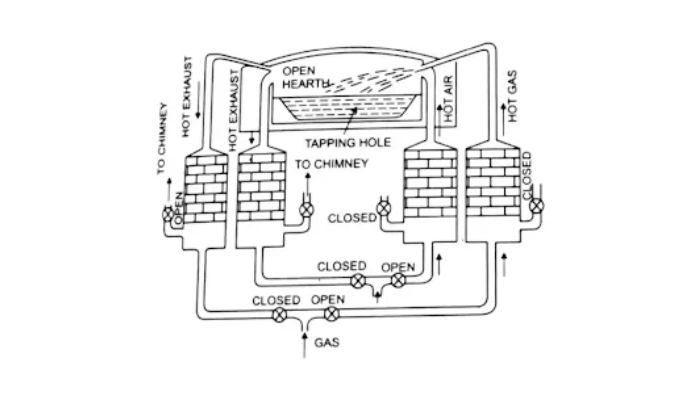Hello, friends today we are going to talk about the manufacturing process of steel in which you will learn different methods of making steel.
Steel, being a versatile alloy, finds numerous applications across various industries, including construction, automotive, aircraft manufacturing, heavy industrial equipment, transportation infrastructure, home appliances, and more.
What is Steel?
Steel is a versatile and widely used alloy of iron and carbon, with the carbon content typically ranging from 0.2% to 2.1% by weight. It is one of the most essential materials in modern manufacturing and construction due to its exceptional strength, durability, and versatility. The addition of carbon to iron imparts unique properties to steel, making it harder and more resilient than iron alone.
Apart from iron and carbon, steel may also contain small amounts of other elements such as manganese, chromium, nickel, and molybdenum to enhance specific properties. The various types of steel are produced through different manufacturing processes, resulting in alloys with diverse characteristics suitable for a wide range of applications. Steel is used in construction, automotive manufacturing, infrastructure development, appliances, machinery, and many other industries.
Steel is an alloy of iron and carbon in which the carbon content varies up to 1.5%.
Manufacturing Process of Steel
The following six methods are used in the process of manufacturing steel.
- Open Hearth Process
- Electric Process
- Crucible Process
- L.D. Process
- Bessemer Process
- Cementation Process
Open Hearth Process
An open hearth consists of a shallow hearth encased with walls and a roof made of refractory bricks. Charging doors are positioned on the walls, and the melting zone is linked to the generator through ports. In this process, pig iron and steel scraps undergo melting and refining in the hearth, utilizing the heat generated by burning fuel.
The furnace’s internal temperature reaches approximately 1500 °C. Throughout the melting process, a portion of the carbon, primarily silicon and manganese, is eliminated through oxidation.
Read also: Are PET Bottles Safe for us and the environment?
Once the metal bath attains the desired carbon content, tapping is performed. This method is employed to produce mild steel and medium carbon steel by reducing the carbon content in iron. Refer to the figure for the arrangement of the open hearth process.

Electric Process
In this process, heat is solely generated using electricity. The temperature is easily controllable and can be regulated consistently. Alloy steels such as stainless steel, high-speed steel, etc., are produced using this method. Refer to the figure for the arrangement of the electric process.

Usually, the following two electric furnaces are used –
- Electric Arc Furnace
- High-Frequency Furnace
Electric Arc Furnace
In an electric arc furnace, the necessary heat is generated by creating an electric arc between carbon electrodes and a metal bath.
High-Frequency Furnace
In high-frequency furnaces, the heat required is produced by an inductor coil carrying alternating current. An alternating magnetic field is created by the electric current induced in the steel. These currents, known as eddy currents, heat the steel as they pass through it.
Crucible Process
In this process, a blend of wrought iron, steel scrap, and ferromanganese is melted with charcoal in a sealed crucible. As the metal undergoes melting, it absorbs the necessary carbon from the charcoal, and the resulting steel is then poured into ingot molds.
Read also: Types of Cutting Tool Materials and Their Properties
Cast steel is usually made using this method.
L.D. Process
The L.D. Process, also known as the Linz-Donawitz process, was developed in Austria in 1949.
This approach employs a basic oxygen converter to produce high-quality steel in a comparatively brief duration. Molten pig iron and steel scrap are utilized in this method, and oxygen is introduced through a water-cooled lance to facilitate the oxidation of carbon and other impurities. After the oxygen flow is complete, the foam is eliminated, and the metal is gathered in a ladle.
See in the figure Linz-donawitz process arrangement.

Bessemer Process
In this method, steel is produced by directing compressed air into molten iron, causing the combustion of excess carbon and impurities in a sizable pear-shaped vessel.
Read also Tool Wear: Types, Factor Affecting, Causes and Remedies
Good quality steel is made using this method.
See in the figure Bessemer process during the manufacturing process of steel.

Cementation Process
In this method, carbon is introduced to wrought iron. Wrought iron bars are enclosed in a container filled with charcoal powder and heated to around 900 °C to create blister steel. The blister steel is subsequently cut into sections, reheated, welded together, and drawn into bars to produce shear steel.
When this steel is reheated, the steel formed is called double shear steel.
So, in this discussion, you’ve learned about various steel manufacturing processes along with their diagrams.
I hope you found this topic enjoyable. If you have any questions or uncertainties, feel free to ask through comments or by reaching out to me directly.

lubricative xyandanxvurulmus.EdWLYPFzAJOO
Hi there, I enjoy reading all of your post.
I like to write a little comment to support you.